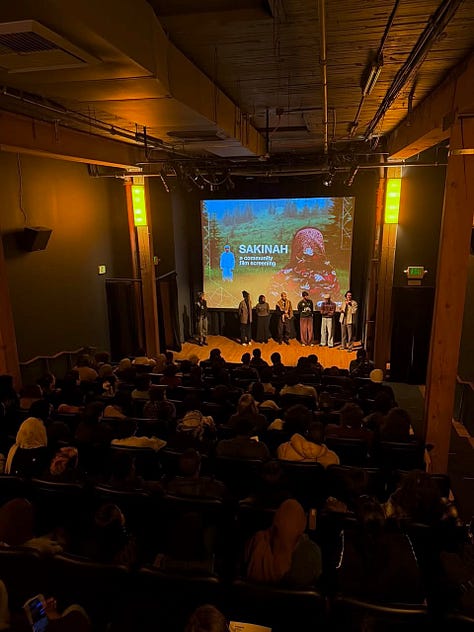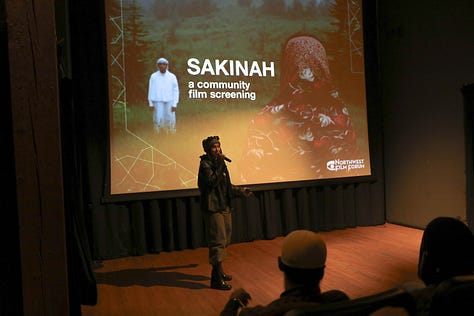Bilal Bikile (San Diego) sits in his office with Mahki Jones’ Inverted American Flag as backdrop at 11 AM on a beaming Wednesday morning in North Park. A FaceTime call is live with Kamyar Mohsenin (Seattle) on the line, locked inside his studio prepping for his upcoming show, Nūr, at Deixis Gallery, set to open on Saturday, May 3, at 6 PM.
The Q&A below is only a small portion of the conversation that took place… Enjoy.
How’s everything going, brother?
Alhamdulillah. I’ve been at the studio every night. I wake up, get ready quickly, and go. Just been there.
When would you say you began considering yourself an artist?
While I’ve been making art my entire life, I only learned it could be a profession when my high school art teacher introduced the idea. And while I’ve been marketing my filmmaking services for years, only recently have I begun earning money as a visual artist, and with that, feeling more comfortable adopting the title.
I take it you must have been creating art since a young age?
It’s all been very natural. I was always making things – involved in theatre, drawing comics, creating animations, sculpting, taking photos. I always give credit to my beautiful mother because she supports my practice, to this day, unconditionally.
Why did you feel compelled to name your first show after your grandfather, Nuri?
My grandfather was my main father figure that filled the Iranian cultural element in my life. He was an incredible husband, father, professor, and photographer. He took thousands of photos that span four generations of our families, encapsulating our history in celluloid memory. It's profound to be witness to my mother’s childhood and her siblings growing up, seeing her smile, and how her face changed over the years. I’m incredibly fortunate I have this.
My grandfather always had a camera on him. He even made himself a darkroom for photo development. So, looking back, I felt it was right for my first show to pay homage to his impression on me and his legacy. I think about how we will all be someone’s ancestor one day, and that idea of what part of yourself will outlive you. There’s something powerful about how even in his passing, he leaves his images behind and I still feel I get to know him through his eyes, and what he was drawn to, and thus who he was.
How does being an art educator to the youth inform and affect your work as an artist?
They definitely inform each other. I’ve been in education for now over 12 years. I started as a teaching assistant at Seven Directions Institute in Santa Cruz, California, where I attended afterschool programs until I started working there. In 2018, I left California and started teaching art in Seattle. I lead all kinds of art classes using different mediums, and the best part about it, it's not too far flung; everything I do is art-related. I leave the studio and go teach art to kids, it's very immersive, and that’s a blessing. Plus, the kids bring so much energy, creativity, a little chaos, all of which makes me feel younger, and also older at times.
What has it been like teaching kids while also starting at such a young age yourself?
Most of the time, my students’ school teachers are not so young, let alone in their 20s. And because I have taught the same age group for some time, the age gap between my students and me is slowly increasing, and the world is drastically changing alongside them. It makes me think about the privilege of the temporary nature of being a young teacher.
On that note of the world changing so swiftly, have you seen the effect of these changes on your youth?
I started teaching in physical classrooms, and I also worked through the pandemic, so with that came a lot of changes to the curriculum. The classroom has in many ways been my lens to the greater fabric of the community I am a part of. I’ve worked in a lot of different types of institutions and organizations, and have witnessed how our youth are now more online than ever. They grow up faster in some ways when they are exposed to so much so early, hence why art feels even more so essential. Its way of means to express oneself, to understand external and internal forces, a mirror to one’s unique circumstance.
What have you learned from your students?
My students teach me courage. They show me that it is more about the journey than the outcome, as most things are new to them. Sometimes we, as adults, lean on our preexisting knowledge a little too much instead of embracing more of what we may not know. But kids have not much to lean on, since most of everything to them is novel. It's very inspiring, and encourages me to try and be more present and courageous myself.
What’s the art community like out in Seattle?
Since I am not from here originally, I can only say so much. I consider it to be a fabulous incubator city for a lot of people. There are many talented and skilled people here from elsewhere, and it's a great city to practice safely within and find your niche. It's been great for me in that way and I consider it an essential chapter in my personal and professional growth. The ceiling feels quite low, however. It prohibits people from earning a sustainable income they require to live in such an expensive city, which causes an exodus to even bigger cities, which then stunts Seattle’s creative culture significantly. There’s not much narrative and contemporary visual work being funded and presented on the main stages, so it's hard for people like myself to find stable footing.
How does it feel to be bringing your first show to California?
California showed love first, which is a blessing since I am from there.
What was your experience like organizing your recent film festival, Sakinah?
I’ve found that I am becoming better at organizing these types of events, but it is very time and energy-consuming, as you know… just so much work. The idea originated with my friend and collaborator Mohamed Abdullahi. We made a film, titled The Mountain and the Flower, and we couldn’t justify a public screening for a 3-minute film. So… we put out a call for a larger community film screening, which we called Sakinah. After a few weeks of planning, getting a theatre venue booked, and promoting it, we ended up having a sold-out show. It felt like we created something Seattle doesn’t see often, as all the curated films happened to be made by and/or about Muslim artists. They were not necessarily about Islam, but a lot of the stories and the values depicted were coincidentally interwoven. The audience was amazing too, and very representative of the stories and images screened.



That’s amazing, man.
Yeah there is something very rewarding about giving back to the arts. A benefit beyond comparison in certain ways.
Can you name some of your favorite directors and films?
Abbas Kiarostami
The Wind Will Carry Us
Hayao Miyazaki
Nausicaä of the Valley of the Wind
Stanley Kubrick
Barry Lyndon
Wes Anderson
Fantastic Mr. Fox
Alice Rohrwacher
La chimera
Jan Švankmajer
Alice
Mohsen Makhmalbaf
Gabbeh
Jiří Trnka
The Hand
Peter Chan
Comrades: Almost a Love Story
Currently reading?
Osamu Tezuka
Is there any literature, media, or content directly informing the work in your show, Nūr?
It's hard to acknowledge what is subconscious, because I don’t necessarily have a mood board of life. My grad school portfolio would say: I’m very much exploring art related to diasporic memory, migration, and the intersection of culture. Organic and environmental systems are also intriguing – how we are from nature, yet do so much to separate ourselves from it, while simultaneously being responsible. Some of the work in the show is about the spiritual resonance of cultural memory in symbolic or material vessels, such as a rug, a plate of food, writing, or language, and the systems of memory and values embedded in them.
For example, have you ever had a meal that reminds you of your mother’s house? It could be that you are having this rich and euphoric experience, while someone else could simply be enjoying a meal. That's why I love it when people notice things in my work that I never would have perceived. I love to ask people the same question, when they pose it to me, like “What does it mean to you?”
What do you hope people will get out of your first solo exhibition?
Insha’Allah, I hope people get to know me genuinely through the work. I’m often not in front of the camera, and I am a pretty private person. And while the show is not specifically about me or anyone in my family, it is me, and I am presenting a very fresh body of work to a community that is very new to me. It holds ideas of a first impression, what I hope to be a positive one, displaying that this is where I am today. It is not a retrospective; rather, it is what I am making now. So insha’Allah, the next show may look entirely different.
What is a message you think the world needs to hear?
The dunya (the worldly life) often pressures people towards the immediate and reactionary. We see how some countries and their communities invest effort into preserving the future for themselves. Where, in contrast to America, the well-being of the land and people on it, for generations to come, is not given importance. That's why I believe we in the West are obsessed with cultural nostalgia, because we’re not given the chance to think about a future that feels all too bleak. In that way, it's been interesting to grow up and exist in a morally bankrupt empire. I believe if we start thinking more about those around us and those to come, as an ummah (community), it will have a positive effect.
May we plant gardens rather than wage wars.
Life is short, but it is long enough to make a difference. Just imagine if we were all unified and shared such a vision.
Kamyar Mohsenin’s solo show, Nūr, opens on Saturday, May 3, 2025 at Deixis Gallery in San Diego, CA.
The opening reception will take place from 6-9 PM iA. Coffee and tea will be sold in-house by FreeWill Coffee. (Please use free and/or paid street parking.)
Please join us.








